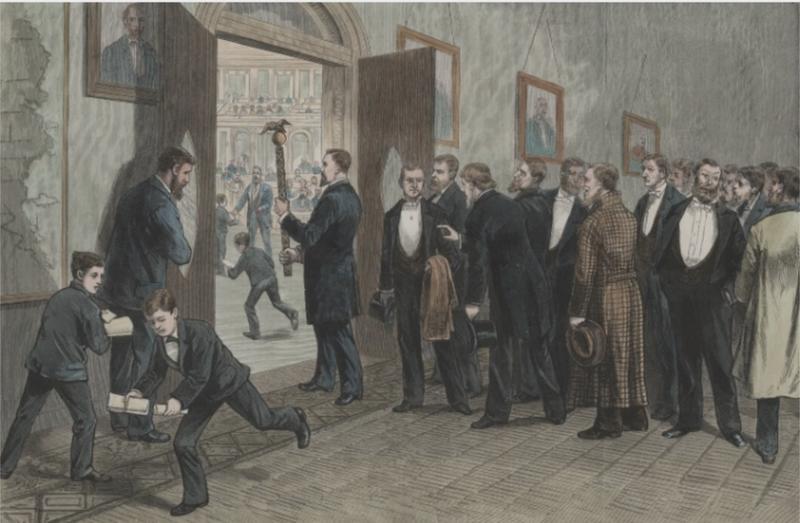Senate Sergeant At Arms: History Of The Police Officer That Protects The U.S Senate Floor
By | January 13, 2021

You may not realize it, but the sergeant at arms and doorkeeper of the United States Senate has one of the most important jobs in the country. The person in this role may not make any decisions for the country, but they protect the people who do.
The Most Important Hall Monitor
On April 7, 1789, James T. Mathers stepped up to the position at the head of the Office of the Doorkeeper for the first United States Congress, but not for the duties the job entails today. At the time, the government had major trouble keeping senators in the Capitol for long enough to meet quorum and get anything done, so Mathers's job was essentially making sure they showed up for work and didn't try to weasel out once they got there. He was also tasked with preventing anyone from interrupting the private sessions so the senators didn't get distracted. Basically, he was the country's most important hall monitor. He was on the job for six years before the sessions became public and the security of senators and aides in the Capitol was added to his job description.

Mandates And Mail
We don't hear about senators getting impeached all that often, but in 1798, Mathers gained the title of sergeant at arms when he was given authorization to compel former senator William Blount to appear in Philadelphia for an impeachment trial after he ghosted the Senate. Following this successful use of power, the sergeant at arms was given additional abilities, such as the power to summon members of the Senate when ending filibusters and compel tardy senators to attend sessions. It's believed that if anyone gets truly out of control in the Capitol, they can be locked up in a detention room that's never been identified in the records of the Architect of the Capitol but may be modern-day room H-159.
By 1829, the sergeant at arms was given dominion over Senate pages, and the office of the sergeant briefly contained the first postmaster. Mathers died in office in 1811, so he never oversaw the mail. That was left to his replacement, Mountjoy Bayly. The Senate's post office still operates under the sergeant at arms's jurisdiction to this day.

Master Of Field Trips
By the mid 1850s, the sergeant at arms truly became a jack of all trades. In addition to covering security for the Capitol and the Senate's mail, the office also looked after the stables and took care of the vice president's car. As the media began to expand in the early 20th century, they assisted with assembling legislative bills and information for the public and arranging interviews for senators.
This change in operations expanded to coordinating official events and visits for the Senate, shuttling senators to and from events as a body, kind of like a teacher busing kids to the planetarium on a field trip. If you ever see a mass of senators somewhere, you can bet the S.A.A. is around to make sure no one strays from the pack.

Guidelines And Gavels
Senators looking to goof off and throw their feet up on the railing of the Capitol are out of luck whenever the sergeant at arms is around (which is all the time). Some of their biggest jobs in the modern era are making sure senators follow the Rules—that is, the Standing Rules, Rules for the Regulation of the Senate Wing, and Rules for Impeachment Trials—and overseeing the use of technology within the Senate. Starting with typewriters and dictaphones through today's computers and various automated systems, they're all the domain of the office of the sergeant at arms, kind of like how your teacher carefully doled out computer time on those special days you got to play Oregon Trail.
The office of the sergeant at arms also holds onto the Senate gavels, which are super old and fragile. The Senate apparently can't be trusted with them for too long, so the sergeant delivers two of them to the Senate floor each day at the beginning of the session and takes them back to their office for safekeeping after the Senate adjourns for the day. At every level, the job of the sergeant at arms and doorkeeper is to treat the highest lawmakers in the country as a group of unruly children. In fact, they still sometimes have to wrangle senators. In 1988, the the S.A.A. had to bring Republican senators in to halt filibustering over a vote on senate campaign finance reform, and with help from the Capitol police, Senator Bob Packwood had to be carried to the Senate floor.

A Farewell To (The Sergeant At) Arms
With so much on their plate, it's no wonder that sometimes the sergeant at arms and doorkeeper of the Senate falters. On January 6, 2021, when supporters of the recently defeated Republican President Donald Trump breached the Capitol and ransacked Senate offices, it was clear that the office of the sergeant at arms had failed to do its job. The day after the riot, Senate Sergeant at Arms Michael C. Stenger resigned his position before he could be fired by the newly Democratic senate after the transition of power.

